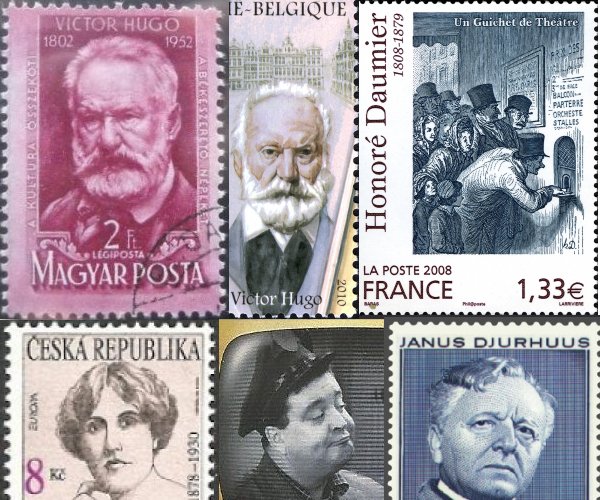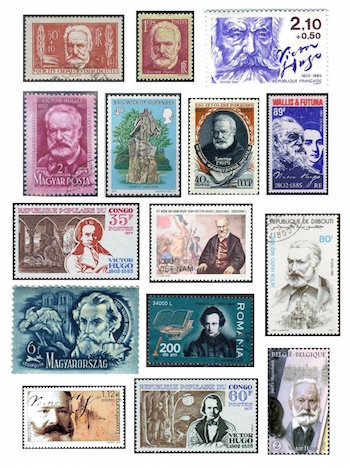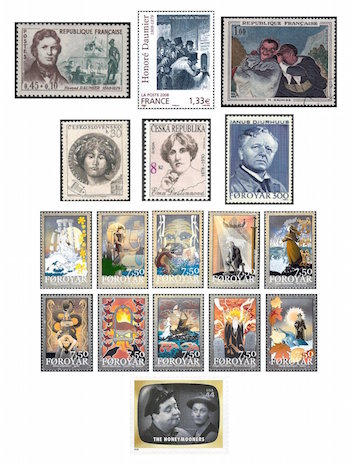The Arts on the Stamps of the World — February 26
An Arts Fuse regular feature: the arts on stamps of the world.

By Doug Briscoe
Two Frenchmen are today’s headliners: Victor Hugo and Honoré Daumier, and we also salute Czech soprano Emmy Destinn, Faroese poet Janus Djurhuus, and “The Great One”, Jackie Gleason.
A few points of interest about Victor Hugo (26 February 1802 – 22 May 1885). He took great pleasure in drawing with pen and ink and left over 4,000 remarkable drawings. More than two million people followed his funeral procession. The city of Hugoton, Kansas is named for him. The Vietnamese religion Cao Ðài (established in 1926) recognizes him as a saint! He lived on the Channel Island of Guernsey from 1855 to 1870; a statue of him (see the stamp in the second row) was unveiled there in 1914, and since 2002 there has been a biennial Victor Hugo International Music Festival. As a music lover, I was surprised to learn that there about a hundred operas based on his plays—to name just a few: Donizetti’s Lucrezia Borgia, Verdi’s Ernani (we just saw a stamp for the play itself yesterday) and Rigoletto (after Le roi s’amuse), and Ponchielli’s La Gioconda (after Hugo’s Angelo, Tyrant of Padua, with a libretto by Boito, whose birthday was two days ago)—and many, many hundreds of songs by such composers as his friends Berlioz and Liszt, as well as by Bizet, Chabrier, Delibes, Gounod, Saint-Saëns, Franck, Fauré, Rachmaninoff, and even Wagner (three settings). Reynaldo Hahn’s most famous song, written when he was just 13, is a setting of Hugo’s “Si mes vers avaient des ailes”. Then there are orchestral pieces such as Liszt’s first and sixth symphonic poems, “Ce qu’on entend sur la montagne” and “Mazeppa”, and Mendelssohn’s overture to Ruy Blas. And then, of course, there’s the hit musical Les Misérables, with music by Claude-Michel Schönberg. That gargantuan novel (greatly admired by Iranian Supreme Leader Ali Khamenei!) was made into films at least five times. One of them has a score by Honegger. Victor Hugo stamps abound, with examples from all around the world. I present a substantial but by no means exhaustive array.

Well, if Hugo produced 4,000 drawings, Honoré-Victorin Daumier (1808 – February 10, 1879), not to be outdone, left that many lithographs, 1000 drawings, 1000 wood engravings, 500 paintings, and 100 sculptures. Of course the visual arts were Daumier’s forte. Daumier’s father was a glazier who moved from Marseille to Paris in 1814 in hopes of becoming a published poet. (I don’t know whether he “made it.”) Daumier himself learned lithography, a skill he used in producing plates for music publishers and illustrations for advertisements. Despite his work in other areas, including fine paintings and three dozen busts of members of the French Parliament, Daumier is best known for his satirical caricatures, one of which, mocking the king, earned him six months in jail. He has even been called the “Michelangelo of caricature”.
Emílie Pavlína Věnceslava Kittlová (1878 – 28 January 1930) took the name of her voice teacher Destinn as a tribute. Born in Prague, she studied violin before turning to voice. Her stage debut was in Berlin in 1898 as Santuzza, and she remained with the Berlin Court Opera for more than a decade. Destinn made her debut at Bayreuth in 1901 (Senta), at Covent Garden in 1904 (Donna Anna), and at the Met in 1908 (Aida). There she created the role of Minnie in Puccini’s La fanciulla del West under Toscanini in 1910. Throughout most of World War I she was under house arrest on account of her outspoken support for Czech independence from Austria-Hungary. She retired from the stage in 1926 and died of a stroke just shy of her 52nd birthday. Destinn also wrote poems, novels, and plays. Her image has appeared on a Czech banknote (1996), and the main-belt asteroid 6583 Destinn is named for her. The stamps are from Czechoslovakia (1953) and the Czech Republic (1996).

If you’re not familiar with the name of Janus Djurhuus (1881 – 1 September 1948), you may readily assume from the set of ten stamps we see here that he was an illustrator, but actually those designs were made to commemorate ten of his poems. Jens Hendrik Oliver Djurhuus, whose great-grandfather was the first poet to write in Faroese, was himself the first modern Faroese poet. He was trained in the legal profession and practiced law first in Copenhagen and later in the Faroes, but his first poem was published in 1901, and in 1914 he published the world’s first book of Faroese poetry. In addition to four further volumes of poems, Djurhuus prepared Faroese translations from ancient Greek and Latin, including the Iliad, German (Goethe and Heine), Italian (Dante), and Swedish (Gustaf Fröding). His own poetry typically combines Classical and Norse mythology, as can be seen in the titles of some of the poems illustrated: the first, at upper left, for example, is for his poem “Atlantis”, the sixth, second row left, is “Loki”. The last one in the set is for a poem called “Cello”. Djurhuus’s younger brother Hans Andreas was also a poet, and they are known as the Áarstova brothers after the house where they grew up.
John Herbert “Jackie” Gleason (1916 – June 24, 1987) was, in my view, a superb dramatic actor (The Hustler, Soldier in the Rain, etc.) as well as a master of comedy. (Gleason was himself actually something of a pool hustler in his youth.) He was orphaned at 19 and started working in clubs and by 24 had small parts in movies, but it was on Broadway (Follow the Girls, 1944) that he had his first notable success. He was hired as the host of Cavalcade of Stars on the short-lived DuMont Television Network in 1950. This program developed into The Jackie Gleason Show in 1954. Although introduced on Cavalcade, The Honeymooners debuted as an independent series in 1955. It never did so well in the ratings in such circumstances as it did when it aired within the broader context of a variety show. Gleason also produced a number of successful record albums—his first, Music for Lovers Only, was in the Billboard Top Ten Charts for 153 weeks, still today the record for longevity. Gleason could not read music but came up with melodies (as for “Melancholy Serenade”) and was by some accounts an able conductor. His grandson is the actor Jason Patric.
As a matter of note, on this date in 1909 the first successful color motion pictures, using the Kinemacolor process, were publicly shown in London.
I must say the fact that there is apparently no stamp for the great Christopher Marlowe (baptised 26 February 1564 – 30 May 1593) is just a damn shame.
A graduate of the University of Massachusetts with a B.A. in English, Doug Briscoe worked in Boston classical music radio, at WCRB, WGBH, and WBUR, for about 25 years, beginning in 1977. He has the curious distinction of having succeeded Robert J. Lurtsema twice, first as host of WGBH’s weekday morning classical music program in 1993, then as host of the weekend program when Robert J.’s health failed in 2000. Doug also wrote liner notes for several of the late Gunther Schuller’s GM Recordings releases as well as program notes for the Boston Classical Orchestra. For the past few years he’s been posting a Facebook “blog” of classical music on stamps of the world, which has now been expanded to encompass all the arts for The Arts Fuse
